Reducing crime is a central mission of local law enforcement, but most agencies have no formal process for detecting and responding to crime problems. As a result, they often employ ineffective blanket strategies to deal with crime problems and ultimately struggle to reduce crime in their community.
Modern policing agencies are problem oriented, evidence-based and think spatially. To reduce crime, they employ operational models like Stratified Policing, the PANDA model, or the SARA model, which rely on data and analytics to identify specific crime problems and respond with appropriate strategies. Responses are continuously evaluated to determine if they were successful, and results are shared with stakeholders to demonstrate transparency. Over time, the evaluated responses become a body of knowledge that help police leaders understand which responses have effectively reduced crime in their community.

To help organizations reduce crime by implementing evidence-based responses to crime problems, the Crime Problem Management solution delivers a set of capabilities that help you manage incident data, identify crime problems, manage evidence-based responses, evaluate response effectiveness, and share results with internal and external stakeholders.
Improve awareness of crime and disorder problems
The Problem Identification project for ArcGIS Pro can be used by a crime analyst to identify, edit, and evaluate crime and disorder problems. A series of tasks helps you document new crime problems to an authoritative web layer, associate crime and call incidents to the problem, update current problems, and prepare hard copy reports for dissemination.
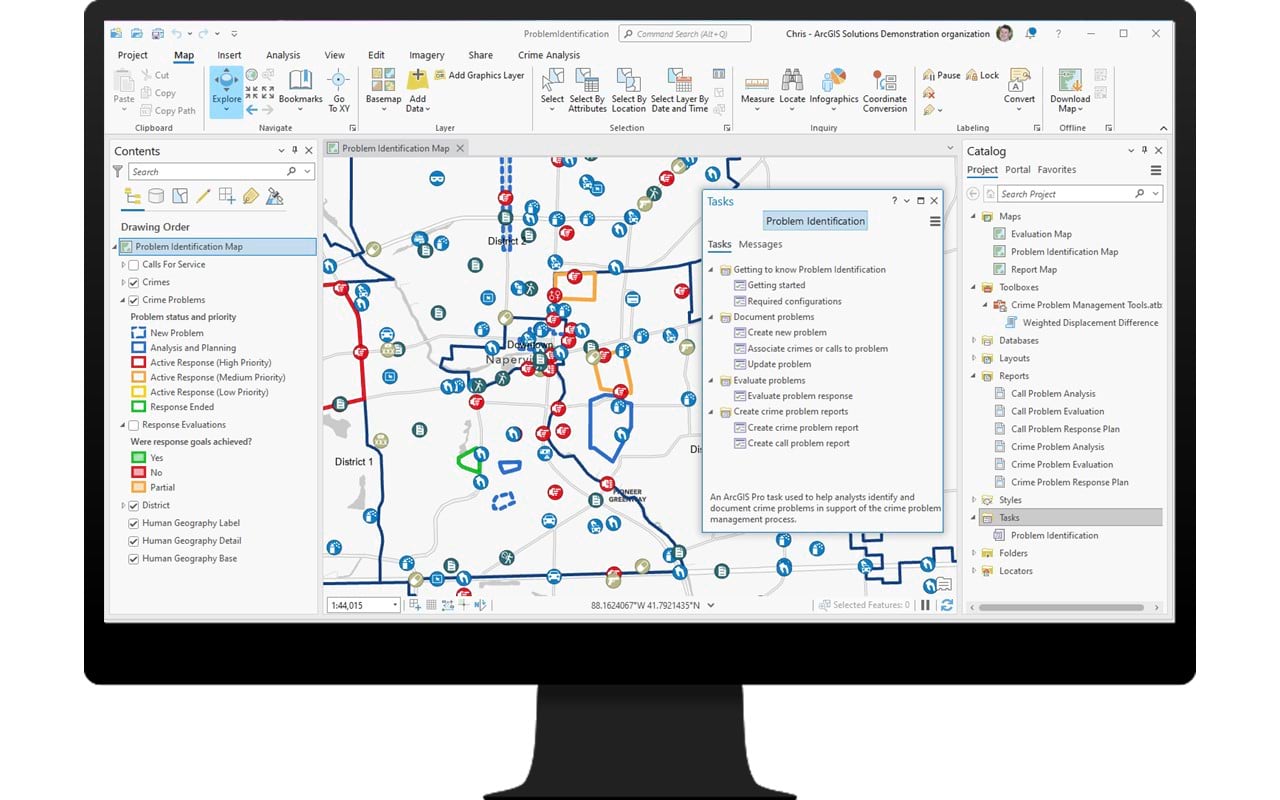
In some cases, problems are identified through means other than crime analysis. A district captain may receive notification about a problem from community members, elected officials, or other stakeholders. In these situations, the New Crime Problem app can be used to capture basic problem details and refer to a crime analyst for workup.
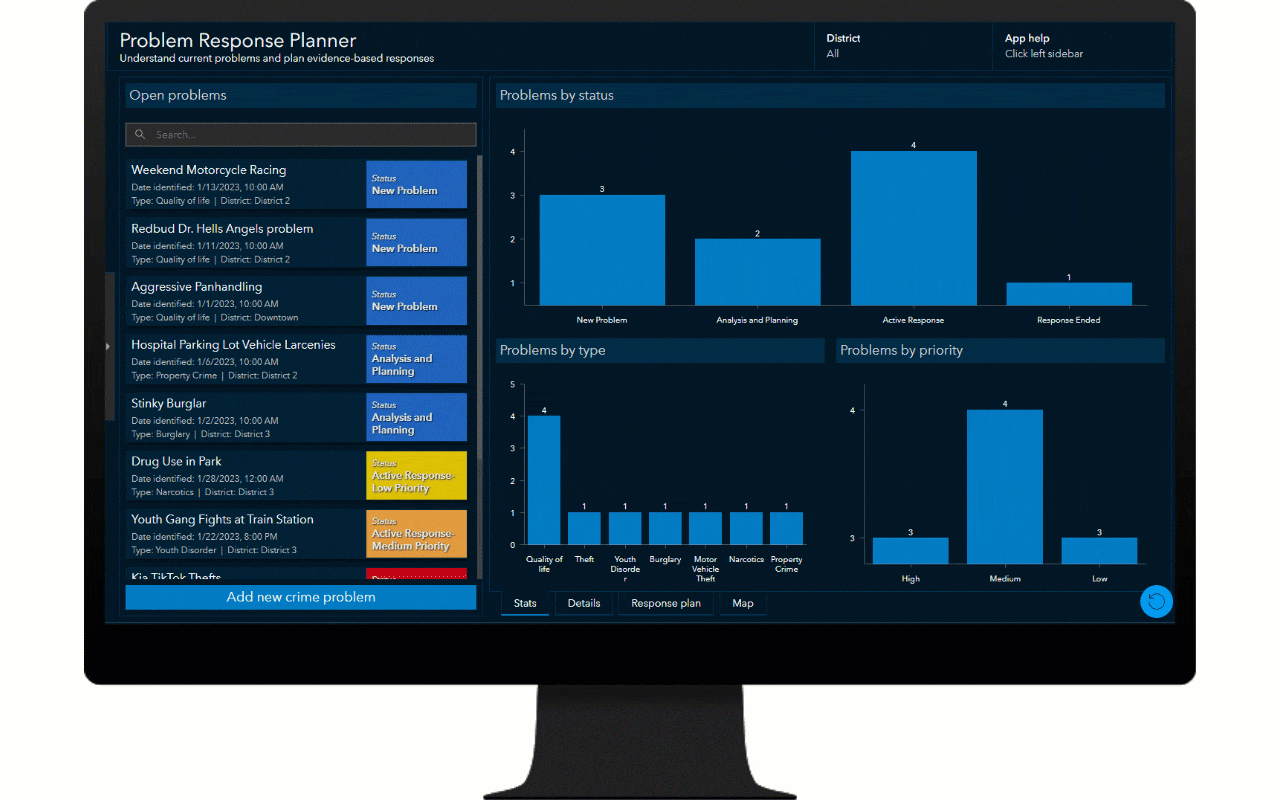
Implement responses and ensure accountability
Once a crime problem has been identified, district captains need to plan a response that uses strategies demonstrated to reduce the problem effectively. The Problem Response Planner app can be used by district captains to understand current problems and plan responses informed by evidence-based best practices.
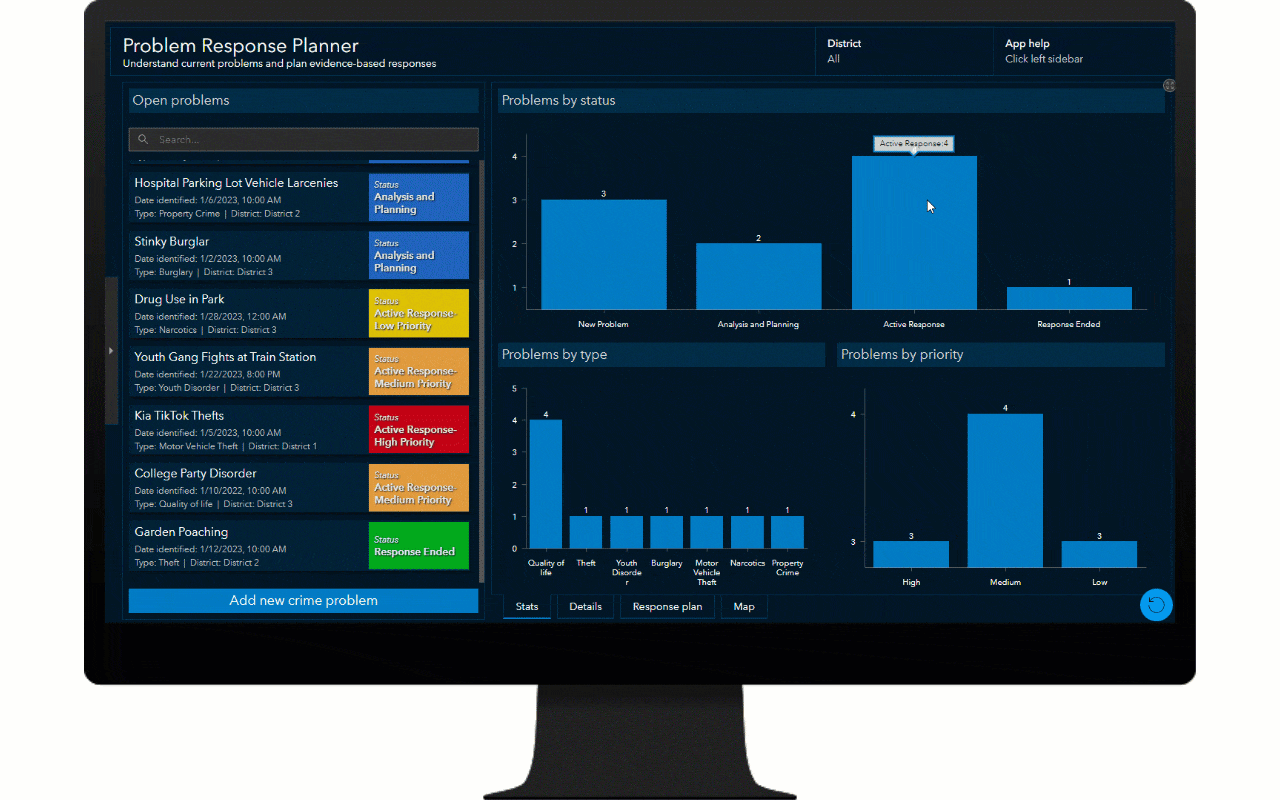
The app displays open problems in varying phases of response. For each problem, a district captain can define a response plan with specific goals, strategies, resources, and a set duration. To help captains choose the right strategy, the app includes external links to organizations that document effective evidence-based strategies. When a plan is complete, a lieutenant can be assigned to coordinate the response and notified via email.
In addition to external resources for choosing effective strategies, district captains can research the strategies used in previous local problem responses to learn what has worked in their own agency.
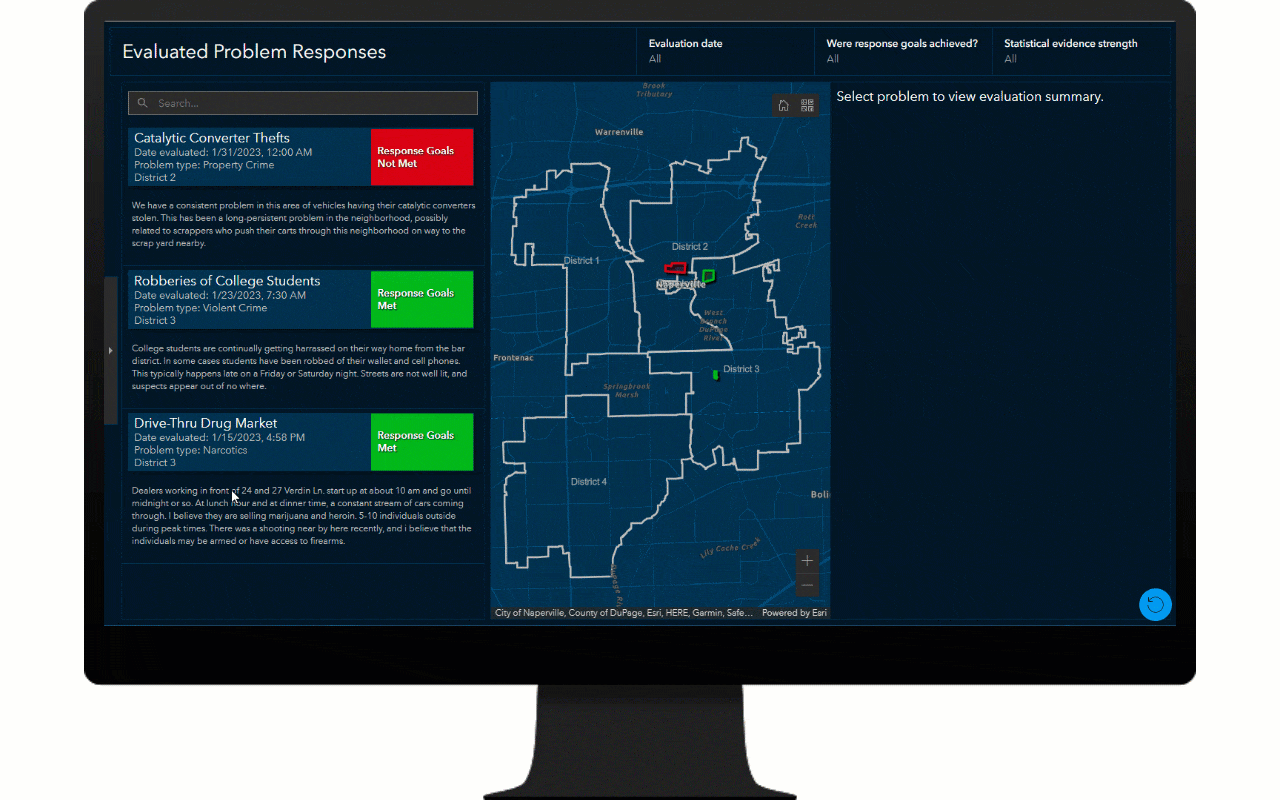
The Evaluated Problem Responses app lets district captains view all historical crime problem responses and their evaluations. Responses can be searched with preset filters or by keyword to learn which strategies to employ and which to avoid.
After a district captain has planned a response, the district lieutenant assigned must coordinate the implementation of strategies designated in the response plan.
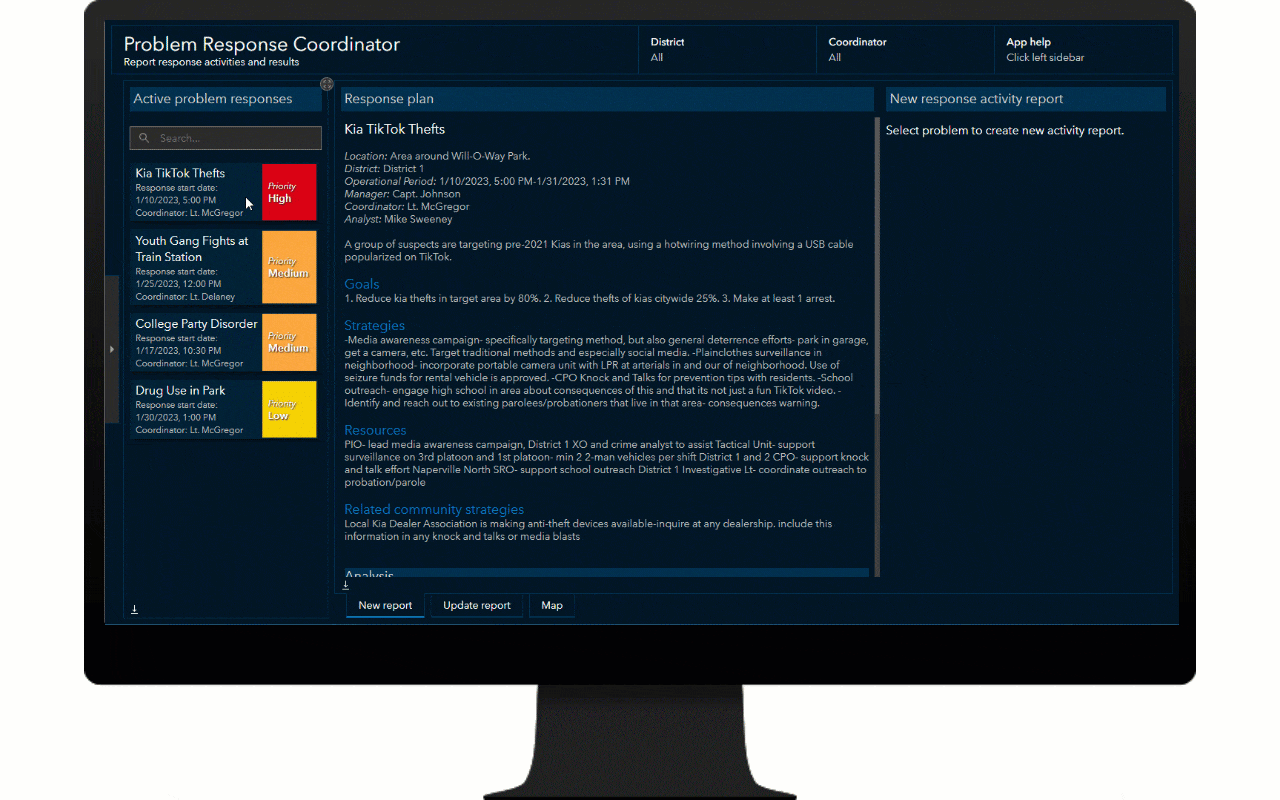
The Problem Response Coordinator app can be used to coordinate the assignment of response activities to operational staff and to report activity results. For each active problem response, a coordinator can view plan details, a map of the problem, related incidents, and create new or update existing response activity reports.
To ensure their agency is effectively reducing crime, command staff, must monitor the overall process to enforce accountability that responses are appropriate to the problem and are being implemented as intended.
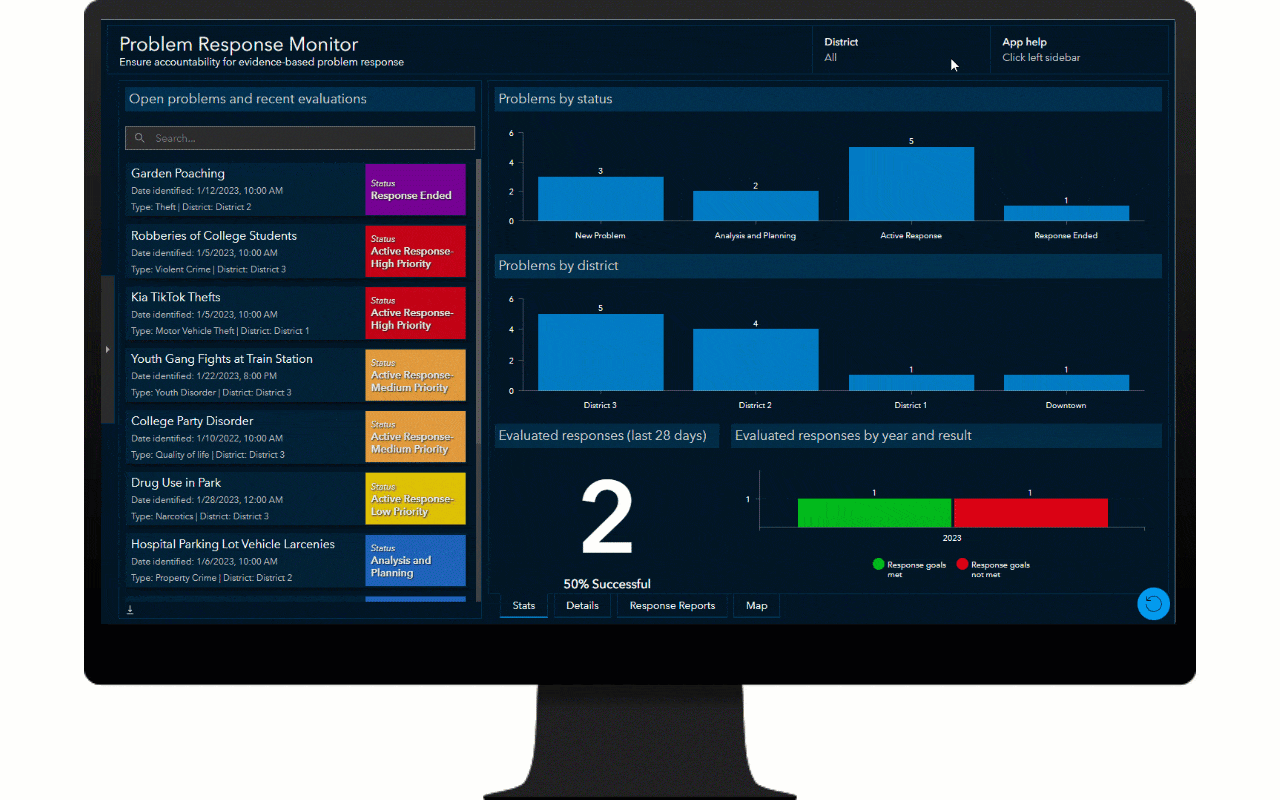
The Problem Response Monitor app can be used by command staff to monitor current problems, ensure accountability for response, and review response evaluations.
Evaluate problem responses to establish best practices
Modern evidence-based agencies evaluate their operational responses to crime problems. Evaluations help determine if responses are reducing crime, and, if not, understanding why, so future response efforts can be improved. To answer these questions, evaluations must assess outcomes using statistical methods (reductions in crime or disorder incidents) as well as process (was the response implemented as intended).
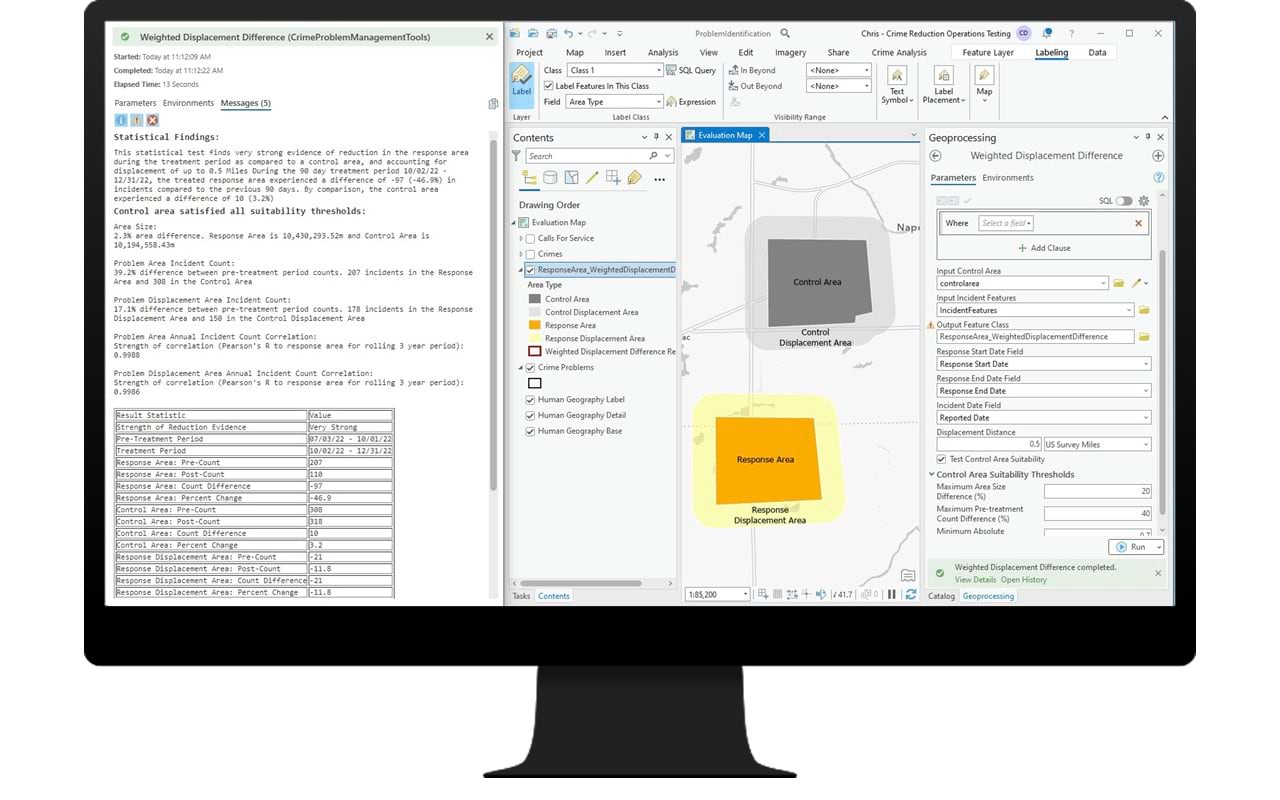
The Problem Identification project includes a geoprocessing tool used by crime analysts to perform statistical evaluations of problem responses using the Weighted Displacement Difference methodology. The statistical test contrasts the response area to a control area, comparing the period of response treatment to the immediate pre-treatment period. To test for displacement, a buffer is also created around each area.
The output of the test provides, in plain language, an understanding of whether, accounting for displacement, crime in the response area was reduced relative to the control area, and if that reduction is statistically significant. In addition to the tool output, ArcGIS Pro project can also produce produce hard copy reports to share with stakeholders.
While crime analysts use statistical tools to evaluate outcomes, the district captain who created the response plan needs to evaluate the implementation process and document lessons learned.
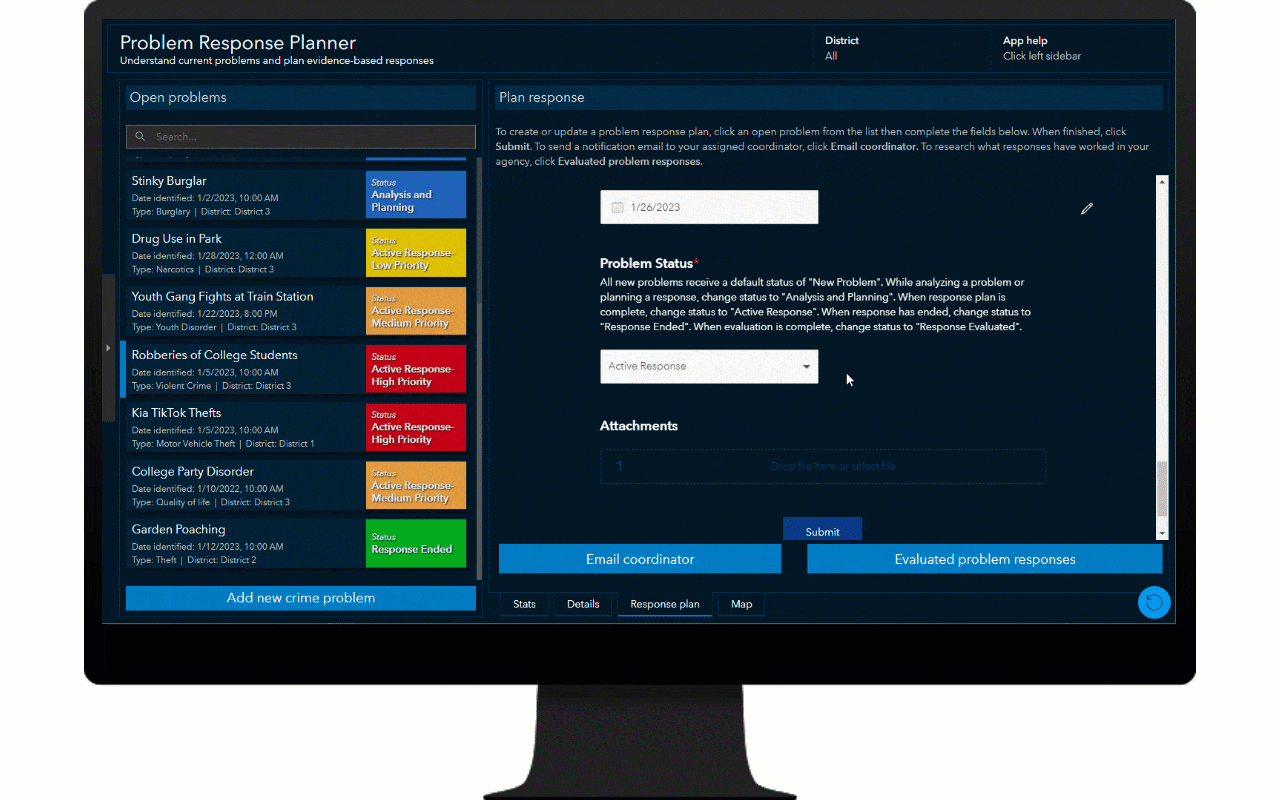
After a problem response has ended, the Problem Response Planner app can be used by district captains to evaluate response implementation and document lessons learned. If the response goals for the problem were achieved, that problem counts a success, and the captain can write summaries suitable for sharing with the public.
Increase transparency and public trust
When problems have been successfully addressed, it’s important for law enforcement agencies to share results with the public to demonstrate accountability and promote their good work.
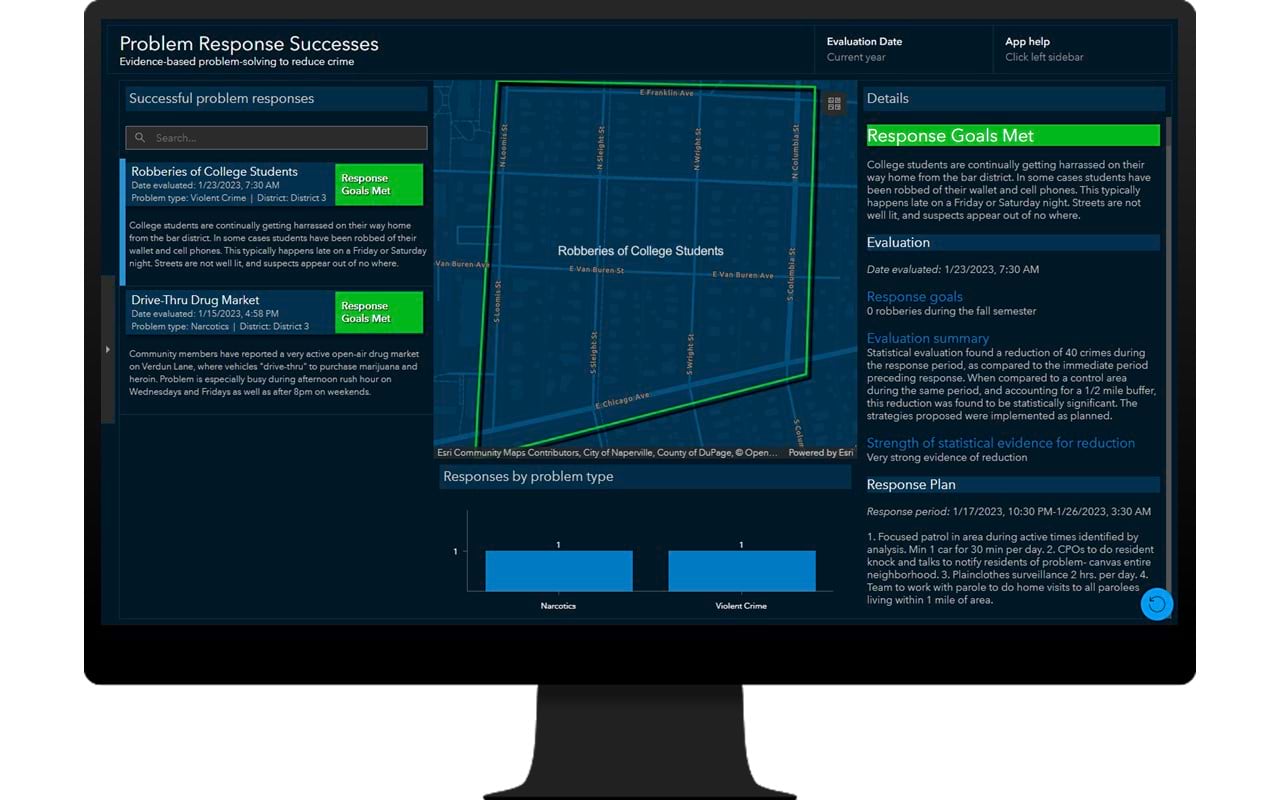
After problem responses are evaluated, the Problem Response Successes app can be used by community members to view a summarized version of successful problem responses.
Streamline mapping of crime and call for service data
Before organizations can effectively identify and respond to crime and disorder problems, they must first be able to map their crime and calls for service data.
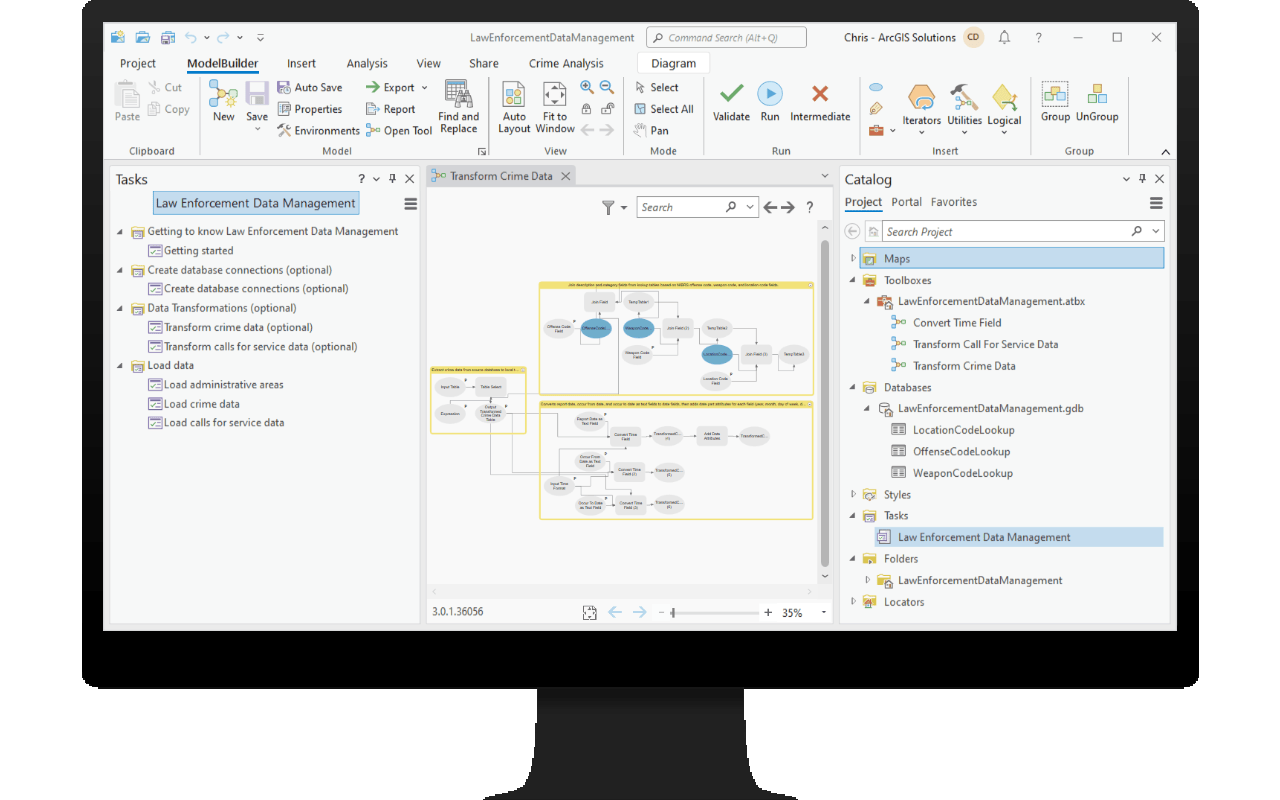
Law Enforcement Data Management is an ArcGIS Pro project used by crime analysts to automate data imports from records management or computer-aided dispatch systems, which helps crime analysts free up time typically spent on data preparation, and facilitates the identification of crime and disorder problems.
A system for improving community safety
Crime Problem Management is part of a larger ArcGIS system for crime reduction operations in law enforcement agencies. These solutions can be used in tandem to enable place-based capabilities for organizations of all sizes and GIS maturity. The solutions can be deployed individually, all at once, or in any combination to support your unique needs.
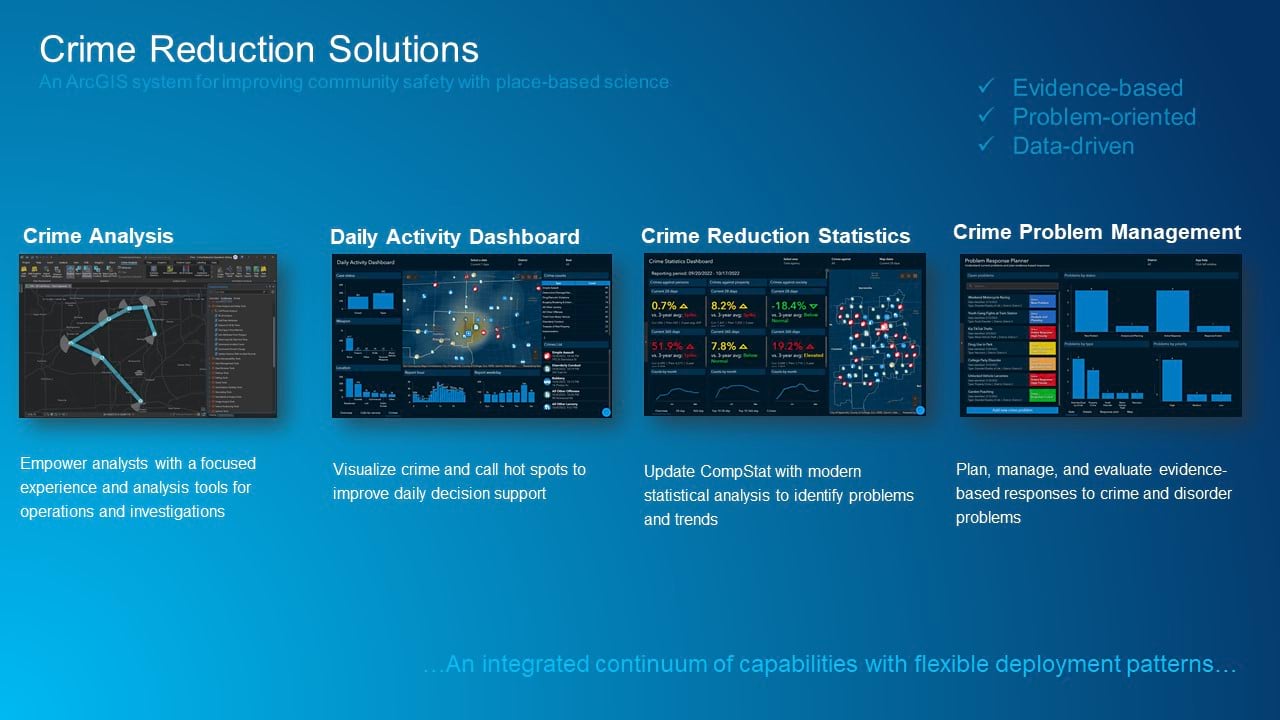
They also share common layers, simplifying subsequent solution deployments, and each comes with tools to facilitate automation of data loading. Each solution in the system is progressively sophisticated, so organizations just starting out can grow over time.
Together, this system of apps helps law enforcement agencies reduce crime by using place-based analysis to understand crime and disorder conditions, implement evidence-based responses, and rigorously evaluate their own responses to establish best practices for the future.
Additional resources
We’re so happy to share this release with you. Below, you can find additional resources you may find useful.
- Watch the Crime Problem Management video to learn more
- Deploy Crime Problem Management solution
- Learn how to configure and use Crime Problem Management
- For questions and feedback, chat with us on Esri Community or contact Esri Support Services





Article Discussion: